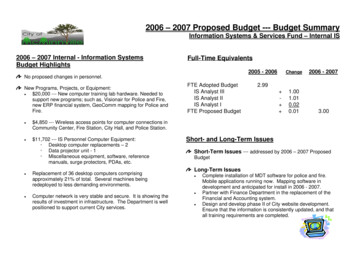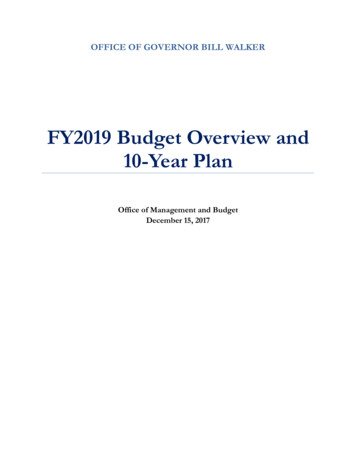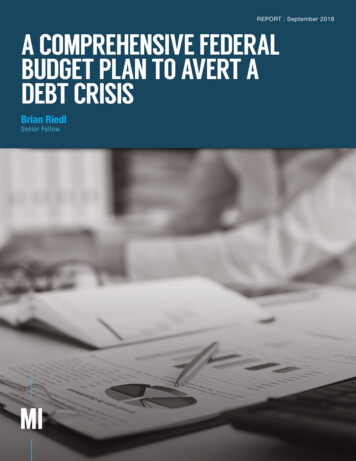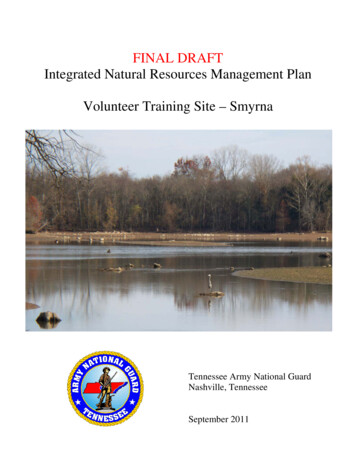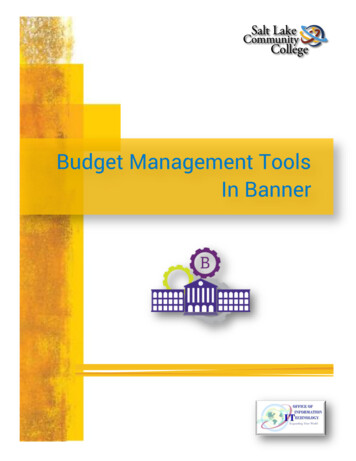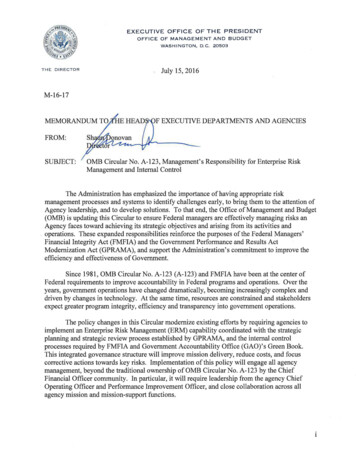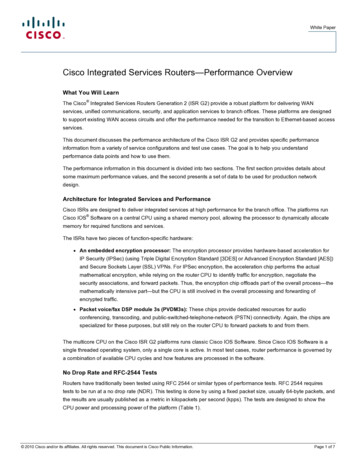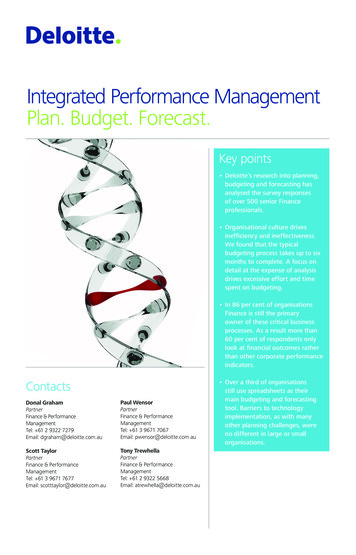
Transcription
Integrated Performance ManagementPlan. Budget. Forecast.Key points Deloitte’s research into planning,budgeting and forecasting hasanalysed the survey responsesof over 500 senior Financeprofessionals. Organisational culture drivesinefficiency and ineffectiveness.We found that the typicalbudgeting process takes up to sixmonths to complete. A focus ondetail at the expense of analysisdrives excessive effort and timespent on budgeting. In 86 per cent of organisationsFinance is still the primaryowner of these critical businessprocesses. As a result more than60 per cent of respondents onlylook at financial outcomes ratherthan other corporate performanceindicators.ContactsDonal GrahamPartnerFinance & PerformanceManagementTel: 61 2 9322 7279Email: dgraham@deloitte.com.auPaul WensorPartnerFinance & PerformanceManagementTel: 61 3 9671 7067Email: pwensor@deloitte.com.auScott TaylorPartnerFinance & PerformanceManagementTel: 61 3 9671 7677Email: scotttaylor@deloitte.com.auTony TrewhellaPartnerFinance & PerformanceManagementTel: 61 2 9322 5668Email: atrewhella@deloitte.com.au Over a third of organisationsstill use spreadsheets as theirmain budgeting and forecastingtool. Barriers to technologyimplementation, as with manyother planning challenges, wereno different in large or smallorganisations.
ContentsForeword 3About the survey 4Definitions 5Executive summary 6Integrating planning,budgeting and forecasting 10Using forecasting properly 12Applying process discipline 17Clarifying decision-making responsibilities 19Exploiting technology 22Conclusion 25AuthorsRichard HortonHead of Finance Research 44 (0) 20 7007 7274rhorton@deloitte.co.ukPaul SearlesSenior Manager, Planning, Budgeting andForecasting Lead 44 (0) 20 7303 3010psearles@deloitte.co.ukIn this publication, references to Deloitte are referencesto Deloitte LLP, the UK member firm of DTTL.Kimberly StoneManager, Finance Performance andAnalytics 44 (0) 20 7007 4877kimstone@deloitte.co.uk
Integrated Performance Management Plan. Budget. Forecast. 3ForewordWelcome to this Deloitte Finance reportinvestigating the barriers to change inplanning, budgeting and forecasting (PBF).In the face of growing internal and external complexity, what could be more importantthan an understanding of where we are today, where we want to be tomorrow, andthe steps we need to take to get there? However, macroeconomic challenges emergingfrom the global financial crisis and increasing stakeholder and consumer demandsmean that traditional PBF processes no longer effectively serve the business.Most executives are aware of this. You do not have to look far in a typical organisationto find business managers who see little value in their PBF activities. While from aFinance perspective improving the budgeting and forecasting processes regularlyfigures on the agenda of Chief Financial Officers. Today it is still top of mind for Financeexecutives but significant change is rare.In an effort to understand the reason for much of this frustration and why so littleprogress has been made Deloitte carried out an in-depth survey of senior Financeprofessionals from around the world and from a wide range of industries.Survey responses suggest that organisational culture is a significant inhibitor of PBFeffectiveness. An inability to change and align values and behaviours both in Financeand the wider organisation is the primary reason why organisations continue tostruggle to improve this critical business process.Deloitte’s view is that PBF does not have to be a source of pain and dissatisfaction.Done well it can and should be a source of competitive advantage.We would like to thank the 597 executives who participated in the survey. We hopethat you find our insights thought-provoking and useful, and welcome your feedback.Simon Barnes
4 Integrated Performance Management Plan. Budget. Forecast.About the surveyROLE OF 1%FINANCEDIRECTORFINANCEMANAGERHEAD OF PLANNING/PERFORMANCE9%11%8%16%INDUSTRY AND GEOGRAPHICAL BACKGROUND OF RESPONDENTSCONSUMERPRODUCTS & RETAILCONSTRUCTION,INFRASTRUCTURE &CAPITAL OLOGY,MEDIA &TELECOMMUNICATIONS9%3%HEALTHCARE &LIFE SCIENCESGOVERNMENT, FEDERAL& PUBLIC SECTOREMEA46%TRAVEL,HOSPITALITY& LEISUREUTILITIES, MINING,OIL & GAS8%OTHER15%4%AsiaPacific12%COMPANY SIZE OF RESPONDENTS46%UNDER 1BN25% 1BN – 5BN10% 5BN – 10BN19%MORE THAN 10BN
Integrated Performance Management Plan. Budget. Forecast. 5DefinitionsStrategic planning To define the strategic objectives and targets that will deliver maximum shareholder valueover the long term. To evaluate strategic business development options, and define and agree high-levelstrategic activities and initiatives.Planning and budgeting To cascade annual targets across the business and agree a performance commitment fromeach business unit and function. To develop detailed bottom-up operational and financial plans to deliver annual objectivesand targets.Forecasting To provide a realistic and projected outlook based on changes in the business environmentand the latest view of expected underlying performance. To allow management to make timely decisions and interventions based on a realisticunderstanding of performance and gap to targets.
6 Integrated Performance Management Plan. Budget. Forecast.Executive summaryThe frustrations that executives feel with planning, budgeting and forecasting oftenleads to a loss of perspective. Executives forget the purpose of PBF. They lose sight ofwhy they plan, what a forecast is for and what they want to achieve in their day-to-dayenterprise performance management. Most importantly they lose sight of the metricsthat they should be monitoring and managing.THE LEVELOF DETAILDEMANDEDFROM PBFREMAINSCONSISTENTLYHIGH.Many organisations are undertaking significant finance transformation activities but theimplementation of PBF best practice still struggles to find traction alongside projects onbusiness partnering, analytics and operating model changes.Similar processes, similar detailResponses to Deloitte’s survey suggest that PBF processes and capabilities areremarkably similar across organisations regardless of company size and industry sector.The level of detail demanded from PBF remains consistently high. Fifty-five per centof organisations have a culture of financial detail, which drives excessive effort anda focus on outcomes rather than the plans to deliver them. The demand for detail issimilar in both large and small organisations. While the impact of a high level of detail isdifficult to quantify in terms of corporate performance, it does create excess time in thebudgeting cycle.Organisations still take a long time to produce their budgets. Forty-two per cent taketwo-to-three months to complete their budget while 32 per cent of respondents takeup to six months. Total effort is difficult to determine when contributions are spreadacross the organisation but it is clear that it is a struggle to achieve fast, efficient andeffective processes.A third of the respondents felt frustrated that plans and budgets were often changedat the top with no clear action or reasoning fed back into the bottom-up plan. It isclearly an unacceptable waste of time, effort and resource to spend over three monthspreparing a set of numbers that few in the enterprise believe and even fewer utilise.Spreadsheets remain ubiquitous in both large and small organisations. Over a third ofsurvey respondents still use spreadsheets as their main budgeting and forecasting tool.Vendor planning tools such as IBM Cognos, Oracle Hyperion or SAP BPC and bespoketools are widely used. However, these tools are typically used to collect data ratherthan to fulfil their primary purpose of developing and modelling budgets and plans.It is clear that organisations are not fully using the capabilities available to them fromtheir planning tools.Only a quarter of respondents use rolling forecasts. Most organisations forecast to theend of the financial year. Smaller organisations are more likely to have implementedrolling forecasts than their larger counterparts.
Integrated Performance Management Plan. Budget. Forecast. 7Successful change rooted in culturePBF is a key component of how information is generated and processed, howdecisions are made and how responses are formulated to steer the organisation andimpact future performance. The processes involved are tightly linked to many others.They involve and connect many people and functions across the entire enterprise.The rules which regulate PBF are deeply embedded in organisational culture andthere can often be a “this is the way we do things here” mind set.Change not only requires processes to be reengineered. A cultural shift must takeplace across all executive and staff communities. It is not just about making Financeprocesses more efficient and effective. It is about making the organisation as a wholemore effective and more responsive. The success of any initiative to improve PBFprocesses is rooted in the culture and behaviour of the whole organisation.Culture is the key to unlocking the potential of planning and forecasting. As expected,a significant proportion of respondents, 34 per cent, agreed that the culture of theirorganisations drives inefficiency and reduces PBF effectiveness. Large and smallorganisations are equally impeded by their culture. Organisations can invest in thebest technology, define clear roles and responsibilities, integrate their budgets withcorporate strategy, and refine their internal processes. However, if behaviours arewrong, particularly the behaviour of leaders, then PBF effectiveness will remain low.An organisation’s approach to performance incentives is a key element in determiningculture. Many organisations pay annual bonuses on how executives and their teamsmeet the plan produced during the PBF process. This provides a perverse incentive.Executives can be tempted to produce a plan with low goals so that it can be easilyoverachieved. This type of sandbagging is often engrained in an organisation’s cultureand planning becomes a process of negotiation. If incentives were linked to actualperformance rather than negotiated targets this culture would not exist. Only whenexecutives understand that there is a better way of driving individual performance willthis change substantially. Altering how bonuses are rewarded and removing the linkbetween incentives and targets can be used as a powerful step in effecting change.CULTURE ISTHE KEY TOUNLOCKING THEPOTENTIAL OFPLANNING ANDFORECASTING.
8 Integrated Performance Management Plan. Budget. Forecast.Top five challengesIn addition to culture five areas emerged from the survey responses as challengesto achieving improved PBF effectiveness: 1 Integrating planning, budgeting and forecasting Thirty-seven per centof respondents admitted to a failure to align their planning, budgeting andforecasting effectively with corporate strategy. In these circumstances there is arisk that the activities of the organisation will be misdirected, lack focus, alignmentand cohesion because expectations have not been properly set.2 Using forecasting properly Sixty-one per cent of survey respondents recognised the importance of forecasting as a way of compensating for the static nature ofbudgeting. However, there is a failure to appreciate how forecasting can enhancecorporate agility and specifically a lack of understanding of how it fundamentallydiffers from planning, budgeting and target-setting.3 Applying process discipline Nearly a third of respondents have no formal mechanism for monitoring and managing forecast quality, while less than half ofrespondents are able to forecast either revenue or costs to within a five per centvariance. Too often PBF processes are poorly defined or they are changed in anad hoc manner. The need for process skills and discipline, especially in forecasting,is not recognised and proper measurement is limited. 4 Clarifying decision-making responsibilities A key differentiator betweenhigh-performing organisations* and the rest is clarity on where responsibility existsfor decision-making within the organisation’s specific operating model. A cleardecision-making framework, reinforced by culture, helps organisations strike theright balance between an inclusive process that engages executives and managersand one where clear decisions can be made swiftly and decisively. 5 Exploiting technology Collecting, aggregating and analysing data via theubiquitous spreadsheet still constrains most businesses, making the processof dynamic forecasting and planning slow, opaque and prone to error. Wherepurpose built software is employed its modelling and analytical capabilities areoften not properly exploited.* High-performingorganisations aredefined as thetop 20 per cent ofrespondents bydescending shareprice performance.
Integrated Performance Management Plan. Budget. Forecast. 9Now that the moment of economic crisis has passed it is time for organisations totackle the long recognised deficiencies in PBF, not only to exploit the opportunities thatlie ahead, but also to ensure that they are better prepared for future crises. The findingsfrom Deloitte’s survey along with the work we undertake with many organisationsacross multiple industries and geographies provide solutions to the obstacles identifiedand to why frustration with planning and budgeting has persisted for so long.Integrated and effective PBF processes have a fundamental role to play in identifyingand exploiting areas where new growth exists and in modelling and managing risk anduncertainty in plans and forecasts. In this way PBF becomes the critical business processthat it ought to be rather than the financially-skewed exercise that is ingrained withinmany organisational cultures.
10 Integrated Performance
survey respondents still use spreadsheets as their main budgeting and forecasting tool. Vendor planning tools such as IBM Cognos, Oracle Hyperion or SAP BPC and bespoke tools are widely used. However, these tools are typically used to collect data rather than to fulfil their primary purpose of developing and modelling budgets and plans.
